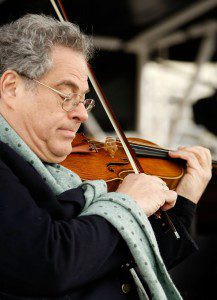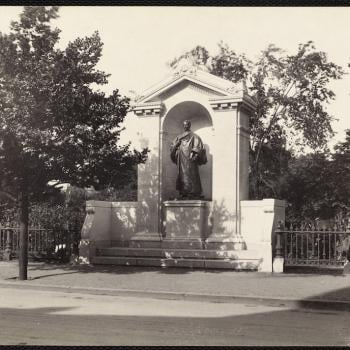The violinist Itzhak Perlman was born on this day in 1945.
One of the more beautiful memories I have of my years out here in New England is a time Jan and I and several friends were at Tanglewood and I got to see and hear the master in person.
And both of these things, my memory of Tanglewood and the fact this is Perlman’s birthday reminds me of that inspirational, but sadly, also, apocryphal story of Perlman losing one string while on stage, but continuing on perfectly. Snopes traces the story to a 2001 Houston Chronicle story, while noting that verification of the details have “proved elusive…”
A somewhat shorter version, and possibly the original, was published two years earlier in an inspirational book by Wayne Dosick:
Childhood polio left Isaac Perlman able to walk only with braces on both legs and crutches. When Perlman plays at a concert, the journey from the wings to the center of the stage is long and slow. Yet, when he plays, his talent transcends any thought of physical challenge.
Perlman was scheduled to play a difficult, challenging violin concerto. In the middle of the performance one of the strings on his violin snapped with a rifle-like popping noise that filled the entire auditorium. The orchestra immediately stopped playing and the audience held its collective breath. The assumption was he would have to put on his braces, pick up his crutches, and leave the stage. Either that or someone would have to come out with another string or replace the violin. After a brief pause, Perlman set his violin under his chin and signaled to the conductor to begin.
One person in the audience reported what happened: “I know it is impossible to play a violin concerto with only three strings. I know that and so do you, but that night, Isaac Perlman refused to know it. You could see him modulating, changing, and recomposing in his head. At one point it sounded as if he were re-tuning the strings to get a new sound that had never been heard before. When he finished, there was an awesome silence that filled the room. Then people rose and cheered. Perlman smiled, wiped his brow, and raised the bow of his violin to quiet them. He spoke, not boastfully, but quietly in a pensive tone, ‘You know, sometimes it is the artist’s task to find out how much music you can still make with what you have left.”
Snopes spends a little time analyzing the Houston Chronicle story and shows it simply could not have happened as reported. It acknowledges the older version is “slightly more credible,” but concludes the anecdote is false. A bit of web searching on my part couldn’t find any word from Itzhak Perlman on the three strings. So, until something new like a statement from Mr Perlman I’m prepared to assume it was a fabrication by Mr Dosick.
Which opens for me a whole roomful of thoughts.
I tend to be a stickler for the facts. When something is attributed to a real person at a real time, well, it should be true. And I mean true in the very basic sense of our shared reality, the one that we move around in, take nourishment from, communicate with one another in, you know, the one we live and die within. That reality…
Mark Twain once observed, “Get your facts first, then you can distort them as you please.”
(Given the circumstances, I thought I better be sure Mr Clemens actually said this, and indeed, he did, in an interview with Rudyard Kipling, published in 1899.)
Get your facts first, then you can distort them as you please.
I’ve noticed a few people on reading the facts regarding the Perlman anecdote have discovered the story was really nothing more than some warm and fuzzy nostrum. That’s one distortion.
Me, when I first read the longer piece somewhere, probably on Facebook, I found it inspirational. When I learned it was made up, I still thought the point of it worthy, that we do the best with what we can and with an implication it will be enough. But, I was past annoyed that a story about triumph over adversity advertised as being real in that true sense not false, was not. Perhaps another distortion?
But I think not. The point falls short, in fact the point feels false when packaged in a fabrication like this.
Which is too bad. Because there is a truth that was held in the middle of the false story.
We’re all broken. When we see ourselves as we are, we see that brokenness.
And there’s a reason it is important to notice this.
We need to see into that truth, each of us, as our personal reality in order to move on to a next step. Not the next step. Too many of us never take it to justly be called the next. We are broken and we remain unconscious of it for whole lifetimes. But there is a step from noticing our brokenness.
It becomes a project for ourselves and on behalf of the world.
There’s a delightful and compelling Hebrew term, Tikkun olam. It means “healing the world.” This is the great project we can embark upon once we’ve seen the state of things as they are.
This is, I find, the work of life. Well, of human life.
We find this as a truth about ourselves, that we are broken, and that we are about healing, then something mysterious and beautiful is birthed into the world.
Is it some cosmic plan? I don’t know. I suspect it is more an accident of our evolution, a side effect of another “plan” entirely. But that doesn’t matter. The universe doesn’t care about our human need for meaning and purpose. It just is.
And, of course, that’s part of our project too. Seeing through our needs. Not ending them. That is becoming dead. But seeing through even as we live. Another ingredient to the great healing project.
What is true, we do this, we engage this, we throw ourselves into the project of seeing our brokenness and taking on the work of healing, and what we find is enough.
Like three strings…













